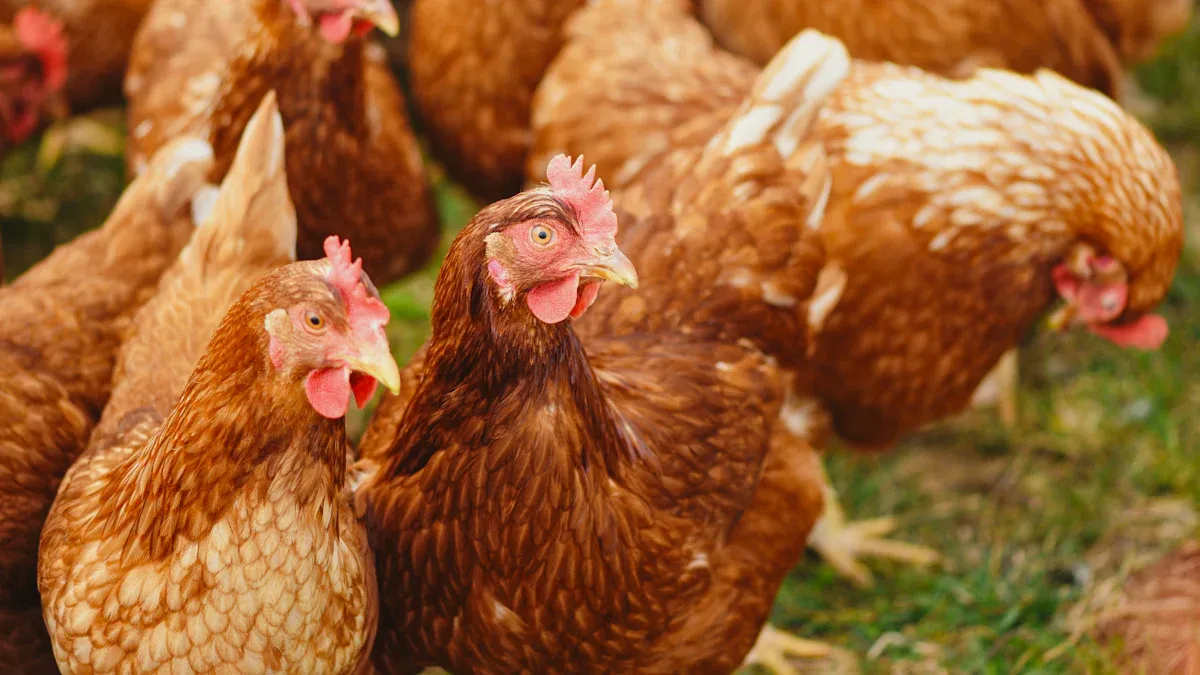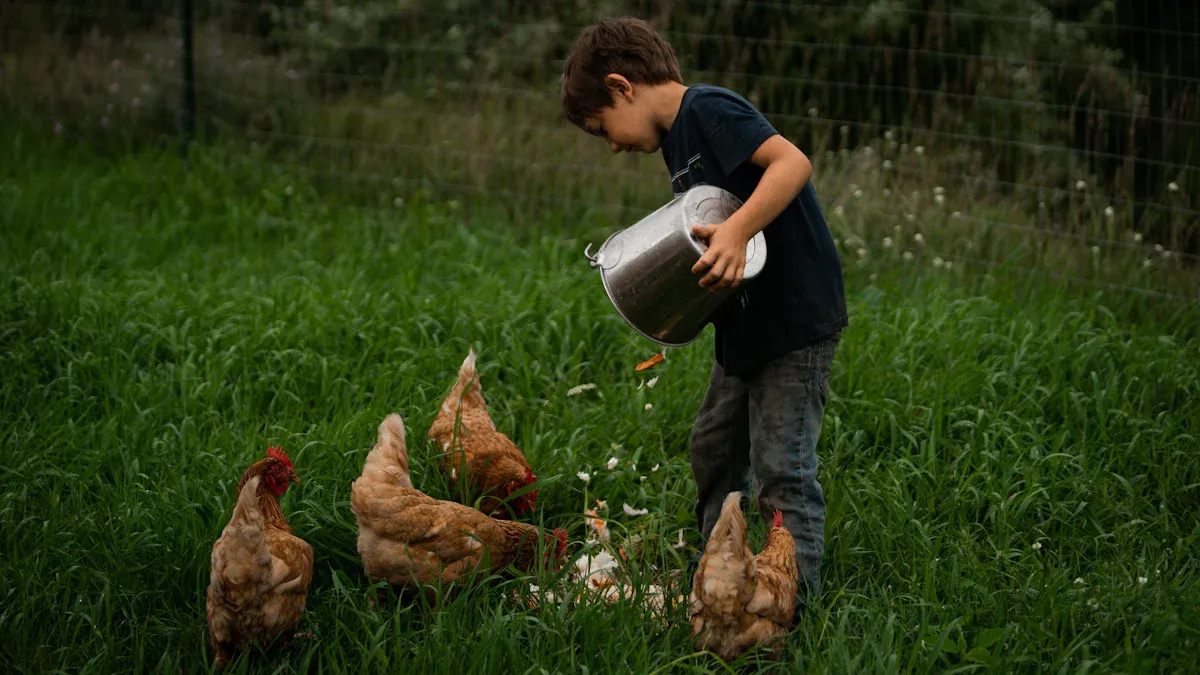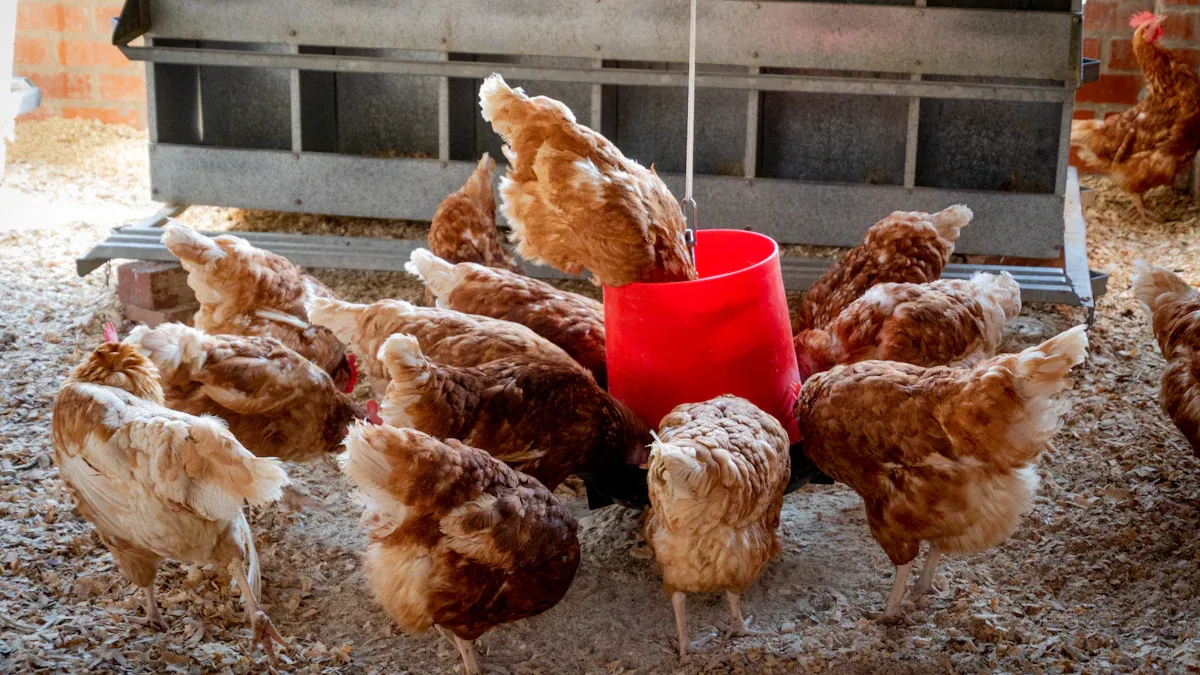
Switching to mealworms for chicken feed supports both animal health and environmental sustainability. Mealworms for Chicken Feed require only 0.2% of the land used by traditional livestock and produce fewer greenhouse gases than cattle or pigs. The table below highlights key sustainability statistics:
| Aspect | Numerical Evidence |
|---|---|
| Land Use | 0.2% compared to livestock |
| Greenhouse Gas Emission | 32%–167% less CO2 than broilers |
| Water Efficiency | 2–3 times less water than chicken protein |
Key Takeaways
- Mealworms use far less land, water, and energy than traditional chicken feed sources, making them an eco-friendly choice that reduces pollution and greenhouse gases.
- Mealworms provide high-quality protein and nutrients that improve chicken growth, health, and egg production while supporting a circular economy by turning food waste into feed.
- Farmers can easily add mealworms to chicken diets in moderation, boosting flock health and profits while sourcing safely from trusted suppliers.
The Case for Mealworms for Chicken Feed

Environmental Impact of Traditional Feeds
Traditional chicken feeds often rely on crops like soy and corn. These crops require large amounts of land and water. Farmers clear forests to make space for feed crops, which leads to habitat loss and soil erosion. The use of fertilizers and pesticides in these fields can harm local ecosystems. Energy use in chicken farming is also high. Facilities need power for lighting, ventilation, and water systems. Transporting feed and chickens adds to greenhouse gas emissions.
| Environmental Factor | Traditional Feed Impact |
|---|---|
| Land Use | Deforestation, habitat loss, soil degradation |
| Water Use | High consumption for crop irrigation |
| Greenhouse Gas Emissions | Significant, from both farming and transportation |
| Nitrogen Pollution | Manure and fertilizer runoff affect water quality |
Note: Sustainable practices like regenerative agriculture and renewable energy can help, but most traditional feeds still have a large environmental footprint.
Why Mealworms Are a Sustainable Protein Source
Mealworms for Chicken Feed offer a new way to reduce the environmental impact of poultry farming. Mealworms need much less land and water than livestock or crops like soy. They do not release methane, a powerful greenhouse gas produced by cows. Farms can raise mealworms on organic waste, such as leftover fruits and vegetables. This process turns food waste into valuable protein for chickens.
| Environmental Aspect | Mealworms | Cows |
|---|---|---|
| Protein Content | 55% protein | N/A |
| Methane Emissions | No methane released | Responsible for 30% of global methane emissions |
| Water Usage | Requires 2000 times less water | High water consumption |
| Waste Reduction | Farms use upcycled materials and feed on organic waste | N/A |
- Mealworms can be raised on dried organic waste, turning food scraps into protein.
- Using food waste as feed for mealworms reduces landfill and pollution.
- Insect farming does not compete with humans for staple crops like corn and soy.
- This approach supports a circular bioeconomy by converting waste into feed.
A recent study showed that mealworms can be farmed using excess heat from data centers. This method cuts production time in half and lowers energy use. The nutritional value of mealworms remains high, making them a strong choice for sustainable chicken feed.
Efficient Protein Conversion and Resource Use
Mealworms for Chicken Feed stand out for their efficient use of resources. They convert feed into protein better than most livestock. This means less feed is needed to produce the same amount of protein.
| Species | Feed Conversion Ratio (FCR) Range |
|---|---|
| Mealworm | 1.6 – 2.1 |
| Poultry | 2.67 – 3.3 |
| Pork | 4.04 – 6.4 |
| Beef Cattle | 18.9 – 25 |
Mealworms have a high edible portion, with 80-100% of their body usable as feed. Chickens and pigs have much lower edible portions. Mealworms also digest and convert organic waste, reducing the volume of waste and creating frass, which can be used as organic fertilizer. Their short digestion time allows for rapid processing of feed and waste.
| Indicator/Metric | Summary |
|---|---|
| Survival Rate | Mealworms adapt to different waste-based diets |
| Waste Reduction | Convert waste into biomass and frass; frass can be used as fertilizer |
| Digestion and Conversion Rate | Efficiently decompose and digest organic waste |
| Life Cycle Impact | No negative effects on breeding or health when fed waste-based diets |
Mealworms for Chicken Feed provide a sustainable protein source that uses fewer resources, reduces waste, and supports a zero-waste circular economy. Their efficient protein conversion and ability to thrive on organic waste make them an ideal choice for modern poultry farming.
Practical Benefits and Integration of Mealworms for Chicken Feed

Nutritional Value and Chicken Health
Mealworms for Chicken Feed provide a rich source of protein, healthy fats, and essential amino acids. Chickens need these nutrients for strong muscles and healthy feathers. Studies show that adding small amounts of mealworm meal to chicken diets improves growth and supports the immune system. Researchers found that chickens fed with mealworm meal had better blood protein levels and healthier cholesterol. These results suggest that mealworms help chickens stay healthy and active.
Boosting Egg Production and Growth
Mealworms support better egg production and faster growth in chickens. Controlled feeding trials compared chickens eating regular feed to those eating mealworm-enriched feed. The table below shows the results:
| Parameter | Control Group | Mealworm Group |
|---|---|---|
| Body Weight Gain (g) | 1322.0 | 1423.3 |
| Feed Conversion Ratio | 1.88 | 1.75 |
| Gross Return (US$) | 0.34 | 0.41 |
Chickens eating mealworms gained more weight and used their feed more efficiently. Farmers also saw higher profits per bird.
How to Add Mealworms to Your Flock’s Diet
Farmers can feed mealworms live or dried. Dried mealworms are easy to store and measure. Chickens enjoy mealworms as a treat or supplement. Most experts recommend feeding mealworms in moderation, not as the main food. A handful of mealworms a few times a week works well for most flocks.
Tip: Use mealworms as a reward to train or tame chickens. They love the taste!
Addressing Cost, Sourcing, and Safety
Mealworms for Chicken Feed offer economic benefits. Studies show that mealworms can improve broiler growth by over 3% and egg production by over 5%. Farmers should buy mealworms from trusted suppliers to ensure safety. Quality products are free from harmful contaminants and meet strict standards. Mealworms also contain natural compounds that help protect chickens from disease.
Mealworms for Chicken Feed offer a smart, sustainable solution for poultry farmers. Reports show strong market growth, high nutritional value, and lower environmental impact.
- The market reached $1.2 billion in 2024 and continues to grow.
- Farmers worldwide choose mealworms for better flock health and sustainability.
Mealworms provide excellent protein. Chickens need a varied diet for best health. Farmers should use mealworms as a supplement, not as the only protein source.


